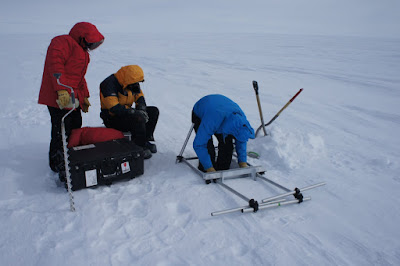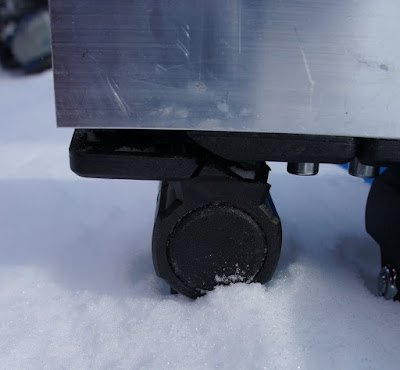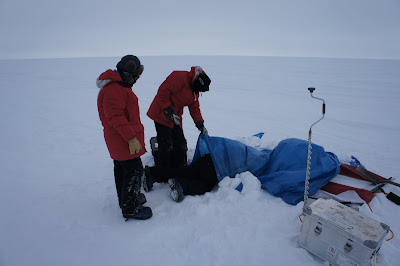Today’s science fell a bit flat, at least on my end. Ruschle and I went out to re-take some albedo measurements, but were frustrated by rapidly-changing cloud conditions that confused the instrument.
Ruschle covers the Sun so I can photograph the clouds around it, in an effort to compensate for their effects; eventually we just gave up.
Mel and Martin had better luck making snow measurements and taking samples. Right now, Martin is sitting behind me with his makeshift lab, pouring diethyl phthalate into snow samples to preserve them. We’ve been having a little trouble getting the stuff cold enough to set, but that’s another post, I think.
Anyway, I figured I’d talk a little more about the rhythms of life in camp. Life in any camp seems to be defined by its chores, so I’ll start with those. Thinking about chores, actually, I was surprised at how few I could come up with. Perhaps that’s because a lot of chores at normal camps involve cleaning things, and we happen to be living in a place with essentially zero dirt.
Responsibilities begin in the morning, when whoever slept with the satellite phone (it has to be kept warm, so it’ll work when it’s needed) calls McMurdo to let them know we’re still OK. Every field camp does this check-in. It’s a sort of failsafe, in case something disastrous happens and we aren’t able to contact anyone to call for help.
Whoever’s cooking breakfast–or sometimes whoever’s in the kitchen tent first–collects a bucket of snow from outside to melt for water. Melting snow is probably the most constant and time-consuming chore. All the water for cooking, drinking, dishwashing, and other miscellaneous uses must be melted in the big pot on the propane stove. Notably, bathing is not really on the list of uses. Living in unheated tents means that getting wet is more or less courting hypothermia, so we mostly do without. I’m sure there are ways to manage it [bathing], but for three weeks, in a place without dirt, we think we can get away with it.
We hold an informal meeting after breakfast to decide, mostly based on the weather, what to do with the day. If we’re going out, we need to take the covers off the snow machines and inspect them before heading out to the field to do science. Coming back, we re-fuel and re-cover the snow machines. Without the covers, the engine compartments fill with drifted snow.
The cook for the day (tomorrow, that’s me) starts dinner while everyone else puts away the scientific instruments. (I’m thinking I might make some kind of Malaysian-style curry.) More snow is melted–again, usually by the Cook for the Day. Someone might sweep the kitchen, if it’s filled up with drifted snow again. Snow is kind of our equivalent of dirt, but it’s much less bothersome, since it generally evaporates if you leave it long enough. Still, when it accumulates in the kitchen, it becomes somewhat irritating.
[SATPHONE CUTS OUT UNEXPECTEDLY]
Supplementary audio post.
Hey, sorry–I think my last post got cut off when the satellite phone went out. Somewhere around where I was talking about how it’s irritating when the kitchen fills up with drifted snow. I’m actually rather surprised that the satphone hasn’t cut out mid-post before now. Unfortunately the WordPress voice-post function is a bit primitive; the only option is to call, leave a post, and hang up. You can’t really edit it afterwards. So, I won’t try to re-record the whole post this time, since I was mostly finished anyway. After dinner, pretty much all that’s left to be done is to wash the dishes and decide who’s going to sleep with the satphone. So, uh, it’s about time for bed here, so I will bid you all goodnight and talk to you soon. ‘Bye.




